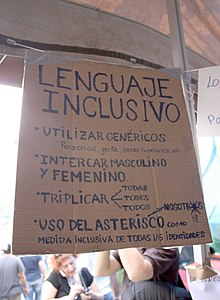Usage of wording balanced in its treatment of the genders in a non-grammatical sense
 A sign at a feminists' protest in Madrid, Spain, explaining gender-neutral, inclusive language in Spanish
A sign at a feminists' protest in Madrid, Spain, explaining gender-neutral, inclusive language in Spanish
Gender neutrality in languages with grammatical gender is the usage of wording that is balanced in its treatment of the genders in a non-grammatical sense.
For example, advocates of gender-neutral language challenge the traditional use of masculine nouns and pronouns (e.g. "man" and "he") when referring to two or more genders or to a person of an unknown gender in most Indo-European and Afro-Asiatic languages. This stance is often inspired by feminist ideas about gender equality.[1] Gender neutrality is also used colloquially when one wishes to be inclusive of people who identify as non-binary genders or as genderless.
